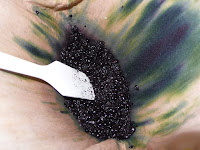Persian Berries: Part II
A decidedly sunny start to October was my cue to collect more Buckthorn. Now that the berries are ripe, they are dark purple, incredibly sticky and bursting with juice. This time my intrepid companion, Damjana, was lured by the promise of a leisurely lunch in the sunshine.
Having collected an ice-cream tub full or berries, and then allowed the spiders and ladybirds to escape, I placed them in a pan, covered them with water and simmered, just until all of the berries had burst. This mixture is then left for a couple of days, before straining through muslin to collect the viscous liquid. This liquid is the Sap Green which was so esteemed by medieval manuscript painters.


A seasonal colour, Sap Green is a rare green organic colour. It is not easily made into a lake, but can be left to evapourate and reduce until it is really jut a sticky (and inedible) jam. traditionally this was then put in a pig's bladder to store. I add a few spoonfuls of alum to stop the solution from going mouldy, and then store it in air-tight camera film cases.
The colour is incredible; a deep dark purple that turns a beautiful bright emerald green when mixed with water. If left undiluted it remains tacky on the page for some time. Cheryl Porter has identified the colour in the Wollaton Antiphonal, a 15th Century manuscript held by the University of Nottingham. In this manuscript, Sap Green was used "all over the place to make a beautiful vivid and seemingly stable green. It was used for the beautiful green of the priests' robes but interestingly, not used to paint the green of the vegetation."
It is not expensive to produce, but neither is it particularly light-fast, however, in the context of manuscript painting, this is far less of a problem as it survives between the decorated pages due to the limited light exposure. Sap Green is also otherwise chemically quite stable, and doesn't incur the damage so familiar in association with copper based greens.
It seems to have been used locally where chalky soils allow the thorny shrub Rhamnus cathartica to grow and therefore might resaonably be expected to appear in many manuscripts from East Anglia.
However, the identification of organic pigments in manuscripts is particularly problematic. Due to the small quantities and thin layers of pigment present, sampling is not suitable, but with non-destructive techniques it can be very difficult to get much more than a vague suggestion of the dyes and lakes which were used by medieval artists.
A new project at the Fitzwilliam Museum, St Luke's Secrets, hopes to begin to unravel some of the mysteries of manuscript production through close examination of the Museum's beautiful collection. Using a range of non-destructive techniques, and working in collaboration with Conservation Scientists, Curators and Chemists, it is hoped that innovative new methods will be found to determine the working practices of medieval painters. I for one am particularly excited about the potential to develop new techniques for the identification of organic colours, and to learn more about how these artists really worked!


 |
Clockwise from top left: Collecting ripe berries; letting the wildlife escape; straining the berries after an initial boil and soak; precipitating the juice in an attempt to make a Sap Green lake.
The colour is incredible; a deep dark purple that turns a beautiful bright emerald green when mixed with water. If left undiluted it remains tacky on the page for some time. Cheryl Porter has identified the colour in the Wollaton Antiphonal, a 15th Century manuscript held by the University of Nottingham. In this manuscript, Sap Green was used "all over the place to make a beautiful vivid and seemingly stable green. It was used for the beautiful green of the priests' robes but interestingly, not used to paint the green of the vegetation."
It is not expensive to produce, but neither is it particularly light-fast, however, in the context of manuscript painting, this is far less of a problem as it survives between the decorated pages due to the limited light exposure. Sap Green is also otherwise chemically quite stable, and doesn't incur the damage so familiar in association with copper based greens.
 |
| A swatch of this year's Sap Green, painted out by a student on Cheryl Porter's Recreating the Medieval Palette course at the Wellcome Library, organised by ICON. |
However, the identification of organic pigments in manuscripts is particularly problematic. Due to the small quantities and thin layers of pigment present, sampling is not suitable, but with non-destructive techniques it can be very difficult to get much more than a vague suggestion of the dyes and lakes which were used by medieval artists.
A new project at the Fitzwilliam Museum, St Luke's Secrets, hopes to begin to unravel some of the mysteries of manuscript production through close examination of the Museum's beautiful collection. Using a range of non-destructive techniques, and working in collaboration with Conservation Scientists, Curators and Chemists, it is hoped that innovative new methods will be found to determine the working practices of medieval painters. I for one am particularly excited about the potential to develop new techniques for the identification of organic colours, and to learn more about how these artists really worked!





Comments
Post a Comment